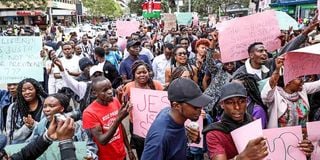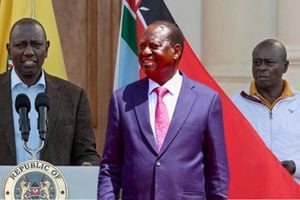
Demonstrators march along Kenyatta Avenue Nairobi on June 23, 2024, during protests against Finance Bill 2024.
The Gen Z revolt has caused the firing of the cabinet, and the withdrawal of the Finance Bill and triggered the resignation of the Inspector General of Police. That is monumental.
Listening to them, at the core of their complaints, is unemployment.
This article attempts to share ideas on how the country can mitigate the issues of youth unemployment.
To do so, it divides youths into skilled graduates and unskilled youth labour. The term unemployment is used in a generic manner and might include underemployment.
Unemployment means people above 18 years not being in paid employment or self-employment but are available for work during the reference period.
Underemployment is the measure of labour utilisation. It often refers to individuals being forced to work in low-paying or low-skill jobs.
In both instances, the unemployed or under-employed is unhappy and a restless soul. For a young man, particularly, it is double jeopardy. Research affirms unemployment reduces the chances of a male being marriageable.
Kenyan jails have a male-to-female ratio of 95:5 respectively. And majority of those males are not married.
Unemployment
We start with graduates' unemployment. The starting point for remedying graduate unemployment should be universities. Kenyan universities have made a good attempt to create employable graduates but one sees the "ivory tower" dichotomy. The synergy between industry and universities can be enhanced to boost graduates' practical skills. In many developed nations, universities are categorised into two. Research universities and those that teach applied sciences. Research universities aim to uncover new knowledge and students join them aiming a research life. Applied sciences are deeply tied up with industries. Maybe Kenya needs this categorisation.
Kenyan public universities admit around 130,000 students per year. Those that actually join are about 100 000. Probably 20,000 drop out midstream and hence probably around 80,000 graduates are churned annually.
Do we have an economy to absorb this number? Government internships can offer fully paid temporary relief.
Assume each of Kenya's 22 ministries absorb 3,000. That would be 66,000 annual intake of graduate interns. Counties and private sector can pick up the balance.
Internships would offer on job practical skills plus some stipend.
But probably graduates upon finishing internships would want to be absorbed. But full absorption has challenges.
Both counties and national government have a wage bill crisis. Salaries consume huge proportions of budgets beyond set legal limits. Yet governments have to undertake development and capital projects which can retard if most of it's budget gets gobbled up by salaries.
To balance the two conflicting goals, a flexible labour market in the government sector can be created to avoid creating "cosseted insiders" and "suffering outsiders".
And this brings us to another possible intervention in government recruitment - civil service recruitment examinations.
Kenya has an outdated civil service recruitment method of "panels interviews". It assumes erroneously that the panel will be objective and fair. But that is granting life and misery powers to select few. Influence peddling and bias problems would only be solved if Kenya adopted civil service recruitment examinations like in Ireland, Sweden, Spain, Italy, China and several Asian countries. Onspot randomised examinations would be the best to reduce the probability of collusion between applicants and recruiters.
Of course this would require a policy shift by Public Service Commission and other Key national government recruiting entities like Judicial and Teachers Service Commission. This would then be cascaded downwards to counties.
Governments cannot compel the private sector to employ more graduates through law or policy. However, incentives can be offered in various ways including targeted tax rebates for companies that progressively hire graduates. When I was in university, KPMG used to conduct open aptitude tests and recruit many graduates.
Remove artificial barriers
The government should also remove artificial barriers to graduate self-employment. Probably delaying repayment of Helb loans would grant graduates a breathing space to get their footing in job market. Nudging banks to configure loaning against "ideas" as collaterals. A doctor who has an idea of opening a hospital should access credit as opposed to insisting on traditional tangible collaterals like land or vehicles. The government can guarantee such idea-based loans. Intellectual property can be made an asset against which loans can be issued.
Statutory professional bodies often place artificial barriers of entry into various graduate professions. Engineering, for instance, has 3,000 registered engineers against 20,000 university graduates. Certified actual scientists are so few, notwithstanding the large number of graduates in that category. The same applies to other professions where there is a huge mismatch between certified professionals and the number of graduates.
A clear and shorter pathway to certification should be provided by law.
For non-graduates, larger reforms to make the economy more dynamic would be needed to absorb the huge army of unemployed youths. But unbundling the National Youth Service would be a low-hanging fruit. NYS annual budget is enough to offer training and stipends to 10 times its current number of youths if restructured and decentralised.
Counties can also form their parallel youth service to complement the national one.
That can easily absorb 400,000 youths in one swoop nationally if the efforts are coordinated both nationally and by counties.
Dr Kang’ata is the Governor of Murang’a County; Email: [email protected]










